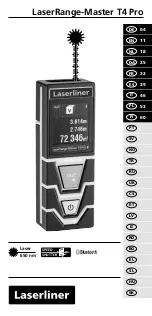
69
SV
104BIS User Manual
There are four basic parameters of audio recording available for all modes:
Wave File Format
(
PCM
or
Extensible
),
Filter
(
Z, A, CB
),
Sampling
frequency (
12kHz
or
24kHz
) and
Signal Gain
(from
0 dB
to
35 dB
).
Continuous
mode means that the audio recording starts with the measurement start and stops with the
measurement stop.
Trigger Slope + / Trigger Slope
–
modes mean that the audio recording starts when rising value of the
Leq
measured in the first profile by
Trigger Step
(with value equal to
Logger step
,
0.5 ms
,
100 ms
or
1 s
) passes
above/below the threshold level (
Trigger Level
), which means for
Slope +
that the previous result was below
the threshold level, and the next one became above the threshold level. The recording lasts for minimum time,
defined by the
Recording Limit
parameter, and during this time the instrument continues to check the trigger
condition with
Trigger Step
interval. Provided that the
Trigger Step
is shorter than the
Recording Limit,
if
next trigger condition is met during the
Recording Limit
time, the instrument triggers recording again, so it will
be continued from this moment by additional
Recording Limit
time and so on. If during next recording time
there are no triggers, the recording will be stopped after the last trigger plus
Recording Limit
time.
Trigger Level + / Trigger Level
–
modes mean that the audio recording starts when the value of the
Leq
measured in the first profile by
Trigger Step
(with value equal to
Logger step
,
0.5 ms
,
100 ms
or
1 s
) is
greater/lower than the threshold level (
Trigger Level
). In other cases, the reco
rding doesn’t start, but if it has
been already started it can be continued until the
Recording Limit
time
has elapsed. If during the
Recording Limit
time a trigger condition appears, the recording will be prolonged for another
Recording Limit
time from the moment of that trigger condition and so on. If during next recording time there
are no triggers, the recording will be stopped after the last trigger plus
Recording Limit
time.
Figure 6-23
Slope +
vs
Level +
wave recording trigger
Note:
In some cases, the instrument may split a wave file automatically! The reason for this is the
limited RAM of the instrument in which the audio data is buffered.
Содержание SV 104BIS
Страница 139: ...139 SV104BIS User Manual 250 Hz 315 Hz 400 Hz 500 Hz...
Страница 140: ...140 SV104BIS User Manual 630 Hz 800 Hz 1000 Hz 1250 Hz...
Страница 141: ...141 SV104BIS User Manual 1600 Hz 2000 Hz 2240 Hz 2500 Hz...
Страница 142: ...142 SV104BIS User Manual 2800 Hz 3150 Hz 3550 Hz 4000 Hz...
Страница 143: ...143 SV104BIS User Manual 4500 Hz 5000 Hz 5600 Hz 6300 Hz...
Страница 144: ...144 SV104BIS User Manual 7100 Hz 8000 Hz 8500 Hz 9000 Hz...
Страница 148: ...148 SV104BIS User Manual Figure C 4 Total directional characteristics asymmetrical axis...
Страница 150: ...150 SV104BIS User Manual 630 Hz 800 Hz 1000 Hz 1250 Hz...
Страница 151: ...151 SV104BIS User Manual 1600 Hz 2000 Hz 2240 Hz 2500 Hz...
Страница 152: ...152 SV104BIS User Manual 2800 Hz 3150 Hz 3550 Hz 4000 Hz...
Страница 153: ...153 SV104BIS User Manual 4500 Hz 5000 Hz 5600 Hz 6300 Hz...
Страница 154: ...154 SV104BIS User Manual 7100 Hz 8000 Hz 8500 Hz 9000 Hz...
Страница 161: ...161 SV104BIS User Manual 1 0 kHz 1 1 octave filter 500 Hz 1 1 octave filter 250 Hz 1 1 octave filter...
Страница 162: ...162 SV104BIS User Manual 125 Hz 1 1 octave filter 63 0 Hz 1 1 octave filter 31 5 Hz 1 1 octave filter...
Страница 166: ...166 SV104BIS User Manual 1 3 octave filters for 16 0 Hz 1 1 octave filter...
Страница 180: ...180 SV104BIS User Manual...
















































